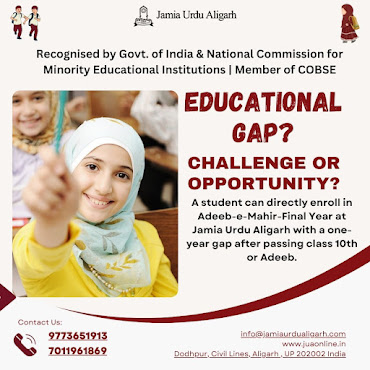Bridging the education gap is undeniably a multifaceted endeavor, encompassing challenges and opportunities alike. At its core, the education gap signifies the divide between those who have access to quality education and those who do not. Within this framework, programs like Adeeb and Adeeb-e-Mahir, pivotal components of educational systems such as the one at Jamia Urdu Aligarh, exemplify both the hurdles and the prospects entailed in addressing this gap.
The Education Gap manifests in various forms, ranging from disparities in resources and infrastructure to differences in curricular offerings and academic support. It represents not only a deficit in access to education but also a deficiency in the quality and relevance of educational opportunities provided to different segments of society.
The 12th Adeeb-e-Mahir Senior Secondary courses stand as a beacon of advanced education, furnishing students with specialized knowledge and skills essential for their academic and professional pursuits. However, access to such programs often remains limited, particularly for marginalized communities and those residing in remote areas where educational resources are scarce. Conversely, the 10th Adeeb program serves as a foundational stepping stone, offering essential education to students at a more basic level. Yet, even this foundational education can be out of reach for many due to socio-economic barriers and systemic inequalities.
The disparity between the 10th and 12th courses underscores broader inequalities within the education system, reflecting a gap in opportunities for educational advancement. While some students have the privilege to pursue higher education and develop specialized skills, others struggle to complete even basic schooling, perpetuating cycles of poverty and marginalization.
Jamia Urdu Aligarh, an esteemed educational institution, plays a crucial role in addressing these challenges. By offering both 10th and 12th courses, it endeavors to cater to students at different stages of their educational journey. However, the institution itself confronts challenges such as limited resources, inadequate infrastructure, and the need for continuous innovation to adapt to evolving educational needs.
Nevertheless, within these challenges lies an array of opportunities for transformative change. By acknowledging the significance of bridging the education gap, we open doors to a more equitable and inclusive society. It is not merely about ensuring equal access to education but also about enhancing the quality and relevance of educational programs to meet the diverse needs of learners.
Investing in education is tantamount to investing in the future. By providing adequate resources and support to educational institutions like Jamia Urdu Aligarh, we empower students from diverse backgrounds to realize their full potential. This entails not only academic support but also holistic development encompassing social, emotional, and practical skills essential for success in the 21st century.
Furthermore, bridging the education gap necessitates a comprehensive approach that addresses systemic barriers such as poverty, discrimination, and inadequate infrastructure. It calls for innovative pedagogical approaches that make education more engaging, relevant, and accessible to all students, irrespective of their background or circumstances.
Innovation is paramount in unlocking the full potential of education. Whether through technology-enabled learning, community engagement initiatives, or experiential learning opportunities, we must explore new avenues to overcome barriers and enhance educational outcomes for all students.
Ultimately, bridging the education gap is not solely the responsibility of policymakers and educators but a collective endeavor for society as a whole. It demands a concerted effort to dismantle barriers, promote equity, and create a more inclusive education system that fosters the development and well-being of every individual.
In conclusion, the education gap presents both a challenge and an opportunity. It challenges us to confront systemic inequalities within the education system while simultaneously offering the prospect of transformative change. By embracing this dual nature of the education gap and committing to action, we can pave the way for a brighter and more equitable future for generations to come.

